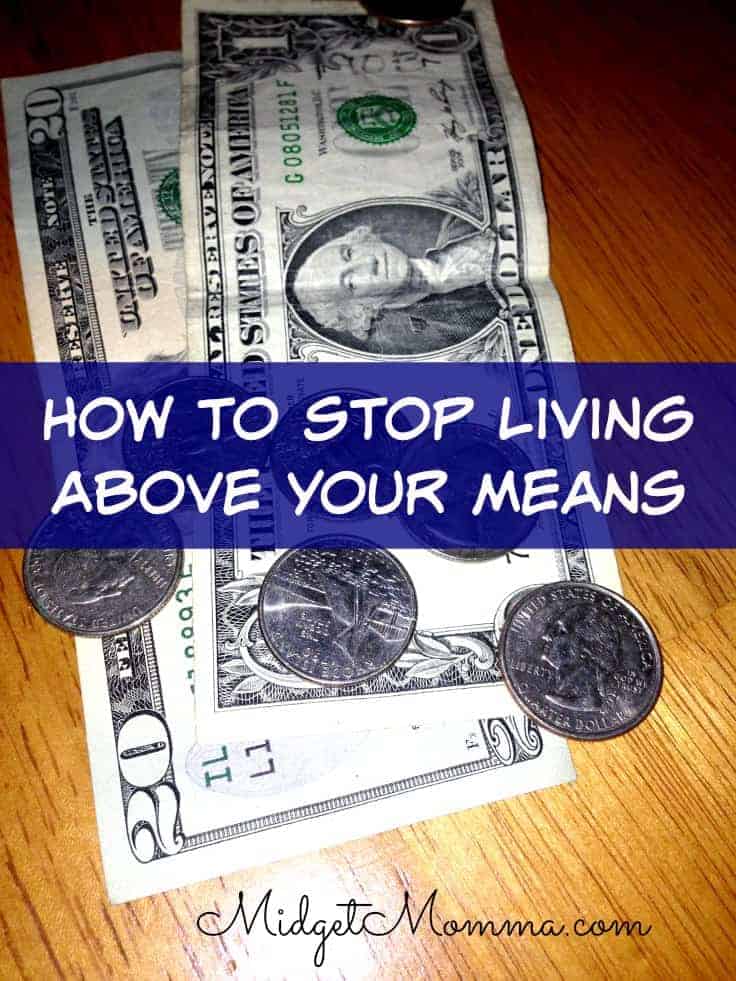Living above your means HURTS your budget, and you are also spending a LOT more money doing it. Cutting back on your spending and learning how to live within your means is an important part of budgeting and becoming financially stable.

How to Stop living above your Means
Living above your means doesn’t just mean spending more money then you make. It also means you are not prepared for if something were to happen. Every month you are paying your bills on time and you think you are doing great. Then the car breaks down, aa kid gets hurt and you have to go to the ER (and pay that deductible), and then the dishwasher breaks.
That is real life, everything happens in threes (or so it seems) and then you sit down to pay the bills and fix the things that are broke and realize that while you thought you were ok you aren’t.
I have been there. It takes a bit of getting into a swing of things and learning exactly what it means to live within your means. I am going to share with you the ways that we got everything on track and now when a bill that is unexpected comes up, we are ok because we have it in savings and make sure we have ourselves covered.
Making sure you have the ability to cover those extras is an important part of living with in your means. You want to make sure you are able to live with in your means with everything not just the monthly bills and expenses.
How to Live within your means
Know how much you make
Ok so this sounds a bit silly, as one would assume that if you are looking at your paycheck each month that you know how much you are making but that is not entirely true. Your take home pay is less then you really make because of taxes and you need to make sure you know how much you are actually bringing home. Also you need to know how much you are making combined in the household if there are two people working. It could be more or less then you actually think you are making.
Know how much you are spending
Yes the bills are paid but do you really know how much money each month you are spending? Making sure you know exactly how much money you are spending is important.
Build an emergency fund
Even if you are living pay check to pay check building that emergency fund so you have the money if something were to come up is important.
Build your savings account. If you lose your job you want to be able to pay your bills while you are hunting for another one.
Rework your budget and don’t spend every cent you make. When you are doing your monthly budget allow the room for there to be extra money. Figure out how much you need for the bills, how much you need for savings and how much to put in your emergency fund but make sure there is money left over after you are done budgeting. You want to spend less then you make.
Be aware of your expenses. Do you know exactly what you spend money on each month? Do you forget to include things like oil changes, pet needs, clothing and many other things in your budget? There are things you might not even think of including in your budget that you spend money on. The budget is more then just the bills you pay for your house and if you are not aware of the other expenses then you will end up living above your means.
Cut out the extras. You can save a TON of money and spend a lot less then you make by cutting out the extras. Dining out, that coffee at Starbucks in the morning on your way to work. While you might have the money to spend think about how much you are spending that could help you get started living below your means.
For example: 1 cup of coffee in the morning at Starbucks = $4 a day. If you work 5 days a week thats 20 day making it $80 a month on coffee. You can buy 72 kcups (which is 72 cups of coffee) for $35 bucks on Amazon.
Here is the break down for 3 months of coffee at Starbucks to buying Kcups to help you save.
3 months of Starbucks coffee: $4 a cup, 20 days a month for 3 months = $240
Buying a 72 count pack of kcups on Amazon for $35 = $35
Total Savings = $205
That $200 is a nice chunk of money you could put in your savings account. You would now have that $200 over 3 months time that could be used incase of an emergency that before you would have been trying to figure out how to get the money for.
These tips will help you to stop living above your means and it may even make it so you are able to live well below your means 🙂
Also check out More Ways to Help you in your financial journey:
- 5 Tips for putting more money in your Savings account
- How to get $1000 in Your Savings Account in a Year
- 52 Week Money Saving Challenge to build your savings account for ways to put money into your savings account.
- 31 Ways to Save $100 or More Per Year Series
- Things forgotten when making a budget







Comments & Reviews
Natasha Straight says
Great tips, thanks for sharing!
Jenny @ Women With Intention says
Hi Lauren! I found you at A Bowl Full Of Lemons! I’d love for you to share this post on my link up (and join in each Wednesday)! I will be back to read more! 🙂 http://womenwithintention.com/women-intention-wednesdays-3/
Jenny
Robin says
Some great yips you have on living within your means! Thanks for sharing!
Sharon - Her Organized Chaos says
Yes yes YES! I am on the same page as you. I think people don’t realize that it isn’t about living less, it’s just living in your means. Thanks for the great tips to help me stay on track. I would love if you linked this up to Totally Terrific Tuesday this week! Hope to see you there.
Sharon
herorganizedchaos.com
Gail Akeman says
Good tips. Make coffee at home and put in a reusable cup.
Celeste Donohue says
I coudn’t survive without s budget! Done it all my 63 years!
Jay says
The one thing that immediately struck me is your use of savings. This is not negative just an interesting thought. You are wonderfully sharing with users this great tip to lelive beneath your means and hank you for the well written article.
There is a but.. in the coffee for example..you break down the per cup for Starbucks but not the kcups… if you can see them side by side you can realize the advantage more. But you can also buy other coffee.. a bag or can and then make the same argument. Starbucks around 4, kcups around .40 cents, pot of coffee…even fancy beans less the .10 cents per cup. You’ll see a relation.
Also telling people that they saved over $200 still means they are still in the marketing trap and the cycle…
If your still spending .60 per days. Your still spending 4 a week, 16 a month, approx 192 per year. 192 per year in a bank at 2 percent is another approx 40 and now you’ve SPENT not saved 240 per year.
We all need coffee and I for one will have multiple cups and try fancy ones…brew at home and treat myself. The tip I’m getting at is one of your first statements… it sounds silly but know what you make.. so this sounds silly.. know what you spend.
Replace all the “save” marketing lingo you as a consumer are bombarded with and take a minute to guard your dollar and translate that to what your spending. . Coupled with this article and knowing what you make.. you’ll have a much better idea on tackling ugly debt issues, savings and more.
Sorry it’s wordy but I felt inspired by the article and thought this would add value! Thanks for sharing your srticle!